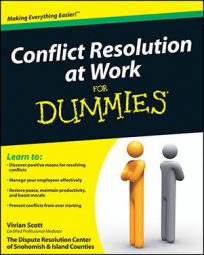How you conclude a conflict-resolution meeting depends on the outcome: the conflict is settled, temporarily settled, or not settled. Whatever the outcome, be sure to offer feedback and clear direction for the future.
Coming to a settlement
When things go smoothly, celebrate! And put your employees’ efforts at the forefront. Let them know that you
Appreciate their hard work
Applaud their efforts
Hope that their agreements will yield a stronger work dynamic for themselves and those they interact with on a daily basis
These conversations can dramatically change relationships. And when one relationship in your workplace changes for the better, it has the ability to radiate to the rest of the group.
Choosing an interim agreement
Not all agreements are fully realized and ready to become full-blown written settlements. In fact, sometimes writing a full agreement may be premature and can become a potential problem down the road. This is where interim agreements shine. Interim agreements are temporary in nature, such as trying out a new communication model for a period of time, or adopting a new policy in the workplace and testing to see its effects.
When you help employees construct such an agreement, both people should understand that it’s for a specific amount of time. Be sure that they’re clear about how long this agreement will last, how they’ll know it’s time to reevaluate, and when they’ll address the outcomes of the interim agreement.
Leaving without a settlement
No matter how hard they try, your employees may be unable to come to a solution. Impasse happens even when employees have the best of intentions and you’re relying on a strong process and skill set. Your employees (and even you) may leave frustrated and disheartened.
As long as you’ve stuck to the process, asked good questions, and encouraged the co-workers to talk with one another, you’ve done all that you can. The process belongs to you, but the solution belongs to your employees. Yet, it’s frustrating to know that you’ve done everything in your power, and still found a roadblock at the end of the trail. End the meeting on a positive note, discuss the next steps that will be taken, and don’t close the door on resolving the situation.

